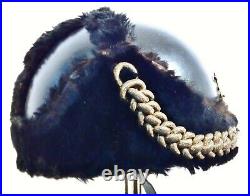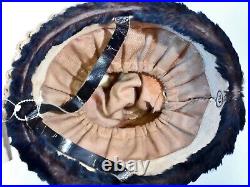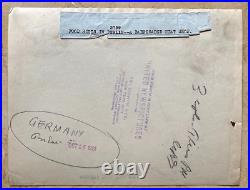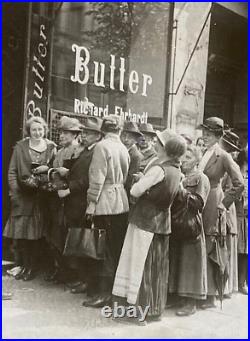


Old pre-WW2 Regular Army. This design was only used May-September 1928! Not hallmarked; screwback fastener. Genuine, not a restrike.









Turnout in the election was officially 99.6% with 99.1% voting’yes’ in Germany and Austria. PRINTED IN GERMANY CIRCA APRIL 1938. In a gigantic advance the standard of living of the German people improved.











ORIGINAL – PRE-WW2 FINAL GERMAN PARLIAMENTARY ELECTIONS of 1938 BROADSIDE. ORIGINAL and IMPORTANT HISTORIC POLITICAL PRE-WW2 FINAL GERMAN PARLIAMENTARY ELECTIONS of 1938 BROADSIDE. Parliamentary elections were held in Germany (including recently annexed Austria) on 10 April 1938. They were the final elections to the Reichstag during Fascist political rule and took the form of a single-question referendum asking whether voters approved of a single list of Fascist and pro – Fascist guest candidates for the 814-member Reichstag as well as the recent annexation of Austria. Turnout in the election was officially 99.6% with 99.1% voting’yes’. ONE OF THE ORIGINAL LIGHTLY USED BROADSIDES THAT WERE HANDED OUT IN GERMANY LEADING UP TO THE GERMAN PARLIAMENTARY ELECTIONS of 1938. THE TEXT OF THE BROADSIDE HIGHLIGHTS SOME POINTS THE WW2 GERMAN LEADER HAD DONE FOR THE CITIZENS. FRONT PAGE STARTS WITH. THE FUHRER GAVE BREAD TO THE ELDERS. BACK PAGE ENDS WITH. WE THANK OUR FUHRER! ALL OF GERMANY HAPPILY GOES TO HIM. WE ALL VOTE YES! PRINTED IN GERMANY CIRCA APRIL 1938. BLACK INK TWO SIDES. LIGHT WEIGHT GROUND WOOD NEWSPRINT PAPER. DIMENSIONS: 8 7/8″ x 12 3/16″.












Straight from the estate of a well-known military antique collector which includes over 30 helmets and pickelhaubes from pre-WW1 and WW2 era that will be listed on my page in the near future (pictures available upon request). Anything mentioned herein is simply my uneducated opinion. The condition of this helmet is excellent, showing no signs of trauma or damage. The exterior leather is in great shape with no signs of crazing and minimal wear. The fur is still mostly intact but looks like some of it has fallen out over time which is to be expected from an item this age. The cloth liner shows light wear and some of the stitches have loosened, but it’s still in great condition. The leather chin strap shows some cracking from age but is still solid and fully intact. This particular helmet has quite the history behind it as it belonged to Royal Air Force Bristol fighter pilot squadron leader Alan Thomas Kingston Shipwright. A veteran of the Great War who was shot down behind enemy lines east of Ypres in August 1917, whilst serving with 19 squadron. Taken POW, Shipwright was a persistent escaper and one of the’Holzminden Tunnellers’ – taking part in the largest and most celebrated POW escape of the Great War, July 24/25 1918. His full history can be found by clicking on the following link. This does not appear to be a reproduction but its authenticity cannot be guaranteed. Stand seen in pictures not included.




Old pre-WW2 Regular Army. Not hallmarked; screwback fastener. It looks like the screw post was reglued; but this DI is quite rare in any condition. Genuine, not a restrike. I will accept a return within 7 days from receipt if there is an error in the description which significantly affects the value. This is in conformance with U.




Old pre-WW2 Regular Army. Not hallmarked; screwback fastener, the tiny pointy bit is missing from the bottom of the back of the badge Genuine, not a restrike. I will accept a return within 7 days from receipt if there is an error in the description which significantly affects the value. This is in conformance with U.







ORIGINAL – PRE-WW2 GERMAN HERMANN ESSER 1928 (JAILED in BEER HALL PUTSCH) POSTCARD RPPC. EARLY PRE-WW2 GERMAN HERMANN ESSER b. 1981 PHOTO POSTCARD RPPC. 19810 was an early member of the National Socialist’s Party in Germany. A journalist, Esser was the editor of the National Socialist newspaper, Völkischer Beobachter, a Propaganda Leader, and a Vice President of the Reichstag. In the early days of the National Socialist’s Party, he was a de facto deputy of Adolf Hitler. At the time of the Beer Hall Putsch on 8-9 November 1923, Esser gave a speech but he told the Leader of the Putsch A. That he was ill and did not actually attend the March. HAND OPAQUED IN THE LOWER RIGHT CORNER OF THE NEGATIVE. CONDITION IS EXTREMELY FINE FOR ITS 95. VERY SHARP FOCUS WITH VERY GOOD CONTRAST. THIS IS NOT A REPRODUCTION OR A COPY.










ORIGINAL – PRE-WW2 FINAL GERMAN PARLIAMENTARY ELECTIONS of 1938 BROADSIDE. ORIGINAL and IMPORTANT HISTORIC POLITICAL PRE-WW2 FINAL GERMAN PARLIAMENTARY ELECTIONS of 1938 BROADSIDE. Parliamentary elections were held in Germany (including recently annexed Austria) on 10 April 1938. They were the final elections to the Reichstag during German Fascist political rule and took the form of a single-question referendum asking whether voters approved of a single list of Fascist and pro – Fascist guest candidates for the 814-member Reichstag as well as the recent annexation of Austria. Turnout in the election was officially 99.6% with 99.1% voting’yes’ in Germany and Austria. ONE OF THE ORIGINAL LIGHTLY USED BROADSIDES THAT WERE HANDED OUT IN GERMANY LEADING UP TO THE GERMAN PARLIAMENTARY ELECTIONS of 1938. THE TEXT OF THE BROADSIDE HIGHLIGHTS SOME POINTS THE WW2 GERMAN LEADER HAD DONE FOR THEM IN THE TIME FROM 1932 TO 1937. Some of the bold faced Headlines, Blurbs and Highlights roughly translated from the Broadside. The leader does what he does! In a gigantic advance the standard of living of the German people improved. Enormous successes have been achieved in all areas. He created new Wermacht! He led 6 1/2 million German Austrians into the Reich! Which statesman thought of looking back on an almost similar great achievement? Because the leader always keeps what he promises, you do at least what you can by giving him your trust. All of Germany in good faith set off on April 10th to him and fine value with: Yes! PRINTED IN GERMANY CIRCA APRIL 1938. BLACK INK TWO SIDES. MEDIUM-LIGHT WEIGHT GROUND WOOD NEWSPRINT PAPER. DIMENSIONS: 8 9/16″ x 11 5/8″. This item is in the category “Collectibles\Militaria\WW II (1939-45)\Original Period Items\Germany\Posters & Prints”. The seller is “topcat2001565758590″ and is located in this country: US. This item can be shipped to United States.
- Conflict: WW II (1939-45)
- Theme: Militaria
- Original/Reproduction: Original
- Region of Origin: Germany
- Country/Region of Manufacture: Germany
- Modified Item: No











PRE-WW2 GERMAN FOOD RIOTS IN BERLIN’A BARRICADED MEAT SHOP’ PHOTO OCT 25,1923. PRE-WW2 GERMAN FOOD RIOTS IN BERLIN’ A BARRICADED MEAT SHOP’ PHOTO OCT 25, 1923. GERMAN POLICEMAN STANDS GUARD LETTING A QUE OF BERLIN’S CITIZENS MOVE THROUGH AN ENTRANCE, (ONE AT A TIME) AT RICHARD EHRHARDT’S MEAT SHOP IN BERLIN. BOYS LACKING SHOES CAN BE SEEN, WINDOW ARE FENCED UP AS SHOPPERS CARRY SMALL BASKETS WITH HOPES OF A MEAGER RATION. ONLY 15 DAYS AFTER THIS PHOTO WAS TAKEN A YOUNG AUSTRIAN PAINTER (ADOLFHITLER) ATTEMPTED A TAKE OVER IN MUNICH OF THE WEIMAR GOVERNMENT, IN WHAT IS KNOWN AS THE BEER HALL PUTSCH (NOVEMBER 9,1923). PERIOD NEWS SLUG DATED DESCRIPTION ON A REVERSE LABEL. FOOD RIOTS IN BERLIN A BARRICADED MEAT SHOP. DIMENSIONS: 8″ x 9 7/8″. SHARP FOCUSED WITH VERY GOOD CONTRAST. THIS IS NOT A REPRODUCTION OR A COPY. This item is in the category “Collectibles\Militaria\WW II (1939-45)\Original Period Items\Germany\Photographs”. The seller is “topcat2001565758590″ and is located in this country: US. This item can be shipped to United States, all countries in Europe, Canada.
- Conflict: WW II (1939-45)
- Original/Reproduction: Original
- Theme: Militaria
- Region of Origin: Germany
- Country/Region of Manufacture: Germany




Old pre-WW2 Regular Army. This design was only used May-September 1928! Not hallmarked; screwback fastener. Genuine, not a restrike. I will accept a return within 7 days from receipt if there is an error in the description which significantly affects the value. This is in conformance with U. This item is in the category “Collectibles\Militaria\1919-38\Original Period Items”. The seller is “badgesareus” and is located in this country: US. This item can be shipped worldwide.
- Country/Region of Manufacture: United States
















































































